Business Information System: Student Work Position Report
VerifiedAdded on 2020/12/29
|13
|3661
|106
Report
AI Summary
This report details the development of a student work position system commissioned by Oulu Specialist College (OSAO) and its Department of Social and Health Care. The assignment focuses on creating a software solution for managing student work positions. The report covers business concepts, characteristics, and social, legal, and ethical issues. It explores software development lifecycles, including requirements analysis, system design, and implementation, and examines various development frameworks, including agile methodologies. The practical part of the thesis involves creating an operational information system to meet the commissioner's requirements, addressing challenges related to information management and access. The report highlights the benefits of an evolutionary business information system that can adapt to changing business needs, and emphasizes the importance of user-driven innovation and customizable technology. The system aims to reduce manual labor, improve information accessibility, and provide solutions to the commissioner's problems.
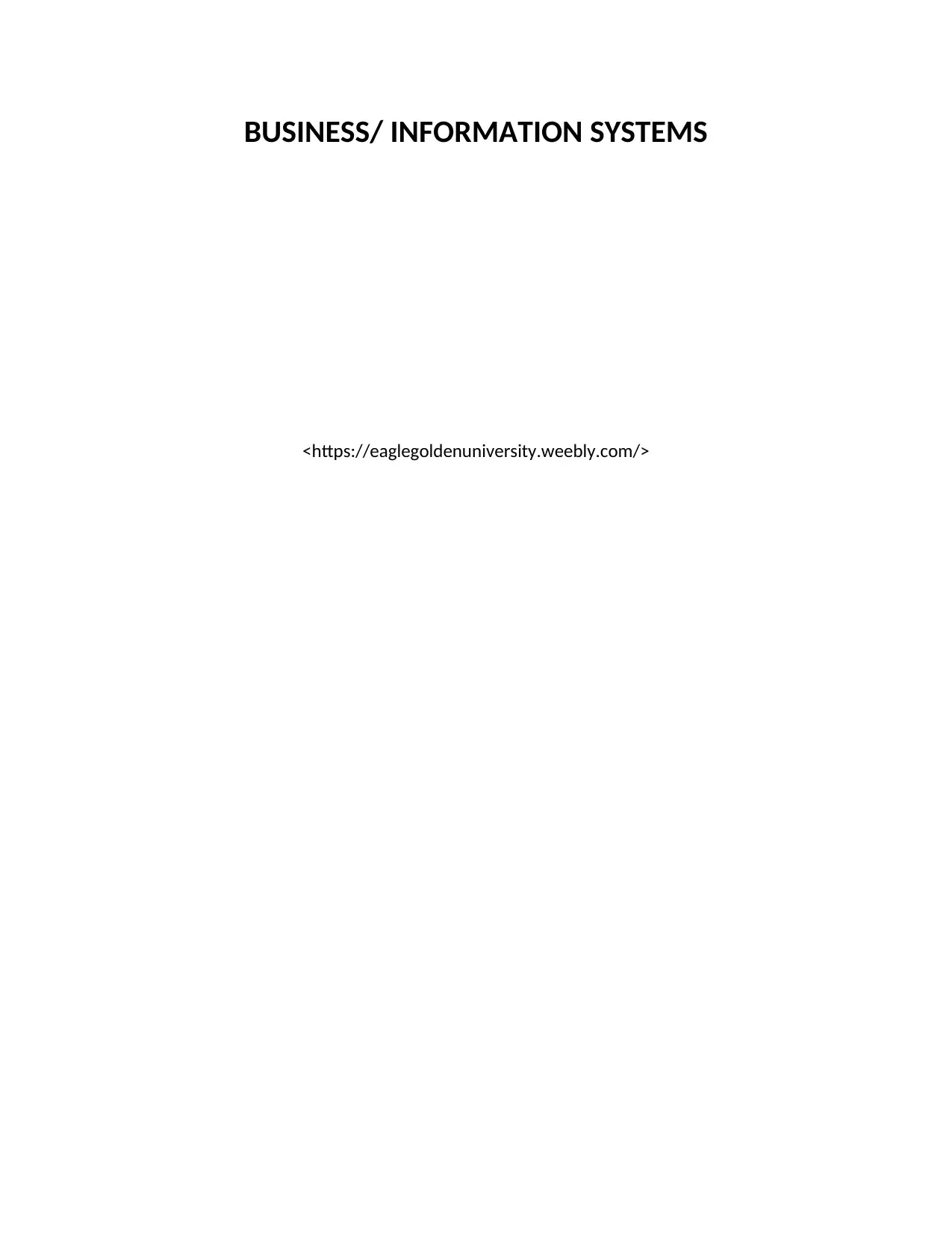
BUSINESS/ INFORMATION SYSTEMS
<https://eaglegoldenuniversity.weebly.com/>
<https://eaglegoldenuniversity.weebly.com/>
Paraphrase This Document
Need a fresh take? Get an instant paraphrase of this document with our AI Paraphraser
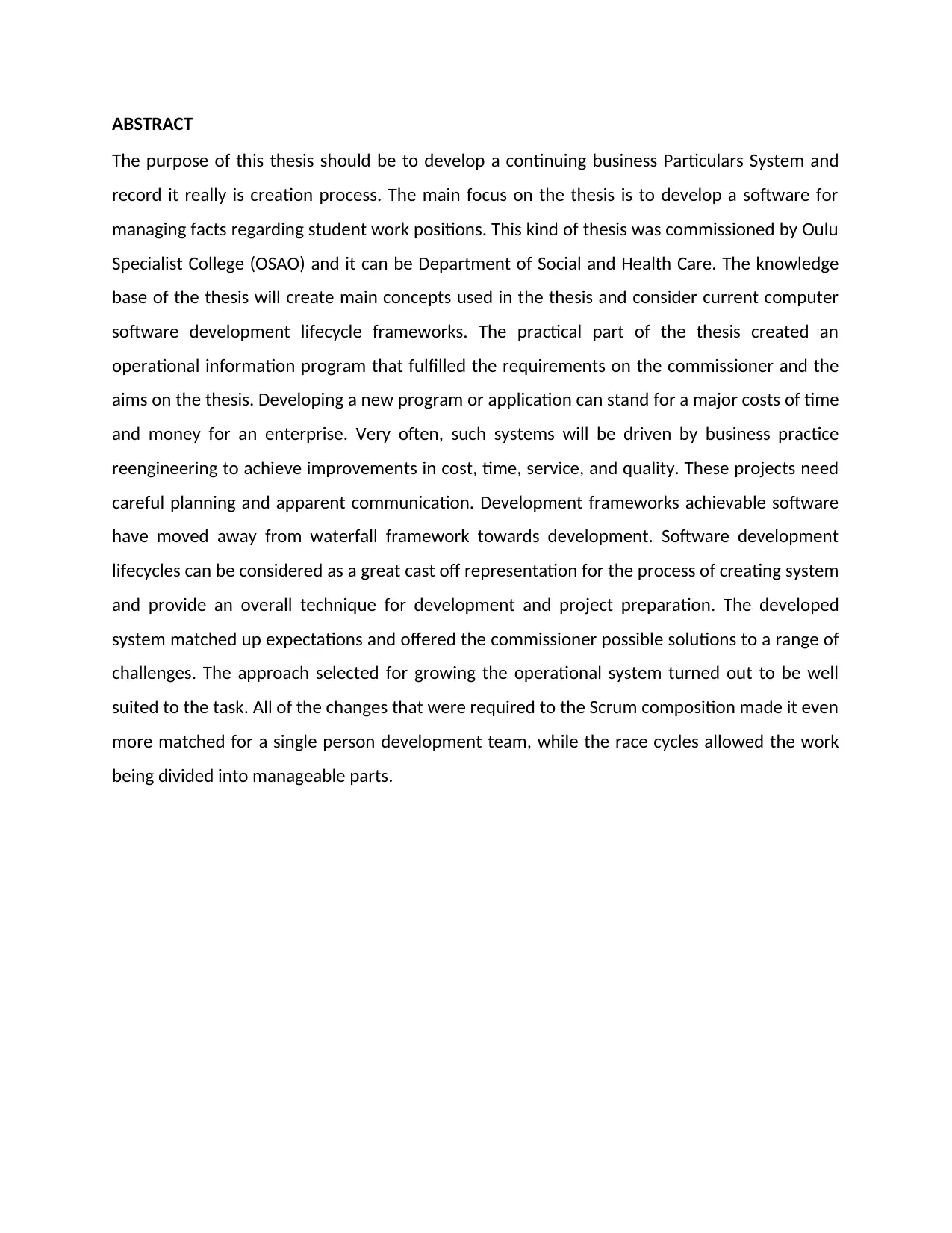
ABSTRACT
The purpose of this thesis should be to develop a continuing business Particulars System and
record it really is creation process. The main focus on the thesis is to develop a software for
managing facts regarding student work positions. This kind of thesis was commissioned by Oulu
Specialist College (OSAO) and it can be Department of Social and Health Care. The knowledge
base of the thesis will create main concepts used in the thesis and consider current computer
software development lifecycle frameworks. The practical part of the thesis created an
operational information program that fulfilled the requirements on the commissioner and the
aims on the thesis. Developing a new program or application can stand for a major costs of time
and money for an enterprise. Very often, such systems will be driven by business practice
reengineering to achieve improvements in cost, time, service, and quality. These projects need
careful planning and apparent communication. Development frameworks achievable software
have moved away from waterfall framework towards development. Software development
lifecycles can be considered as a great cast off representation for the process of creating system
and provide an overall technique for development and project preparation. The developed
system matched up expectations and offered the commissioner possible solutions to a range of
challenges. The approach selected for growing the operational system turned out to be well
suited to the task. All of the changes that were required to the Scrum composition made it even
more matched for a single person development team, while the race cycles allowed the work
being divided into manageable parts.
The purpose of this thesis should be to develop a continuing business Particulars System and
record it really is creation process. The main focus on the thesis is to develop a software for
managing facts regarding student work positions. This kind of thesis was commissioned by Oulu
Specialist College (OSAO) and it can be Department of Social and Health Care. The knowledge
base of the thesis will create main concepts used in the thesis and consider current computer
software development lifecycle frameworks. The practical part of the thesis created an
operational information program that fulfilled the requirements on the commissioner and the
aims on the thesis. Developing a new program or application can stand for a major costs of time
and money for an enterprise. Very often, such systems will be driven by business practice
reengineering to achieve improvements in cost, time, service, and quality. These projects need
careful planning and apparent communication. Development frameworks achievable software
have moved away from waterfall framework towards development. Software development
lifecycles can be considered as a great cast off representation for the process of creating system
and provide an overall technique for development and project preparation. The developed
system matched up expectations and offered the commissioner possible solutions to a range of
challenges. The approach selected for growing the operational system turned out to be well
suited to the task. All of the changes that were required to the Scrum composition made it even
more matched for a single person development team, while the race cycles allowed the work
being divided into manageable parts.
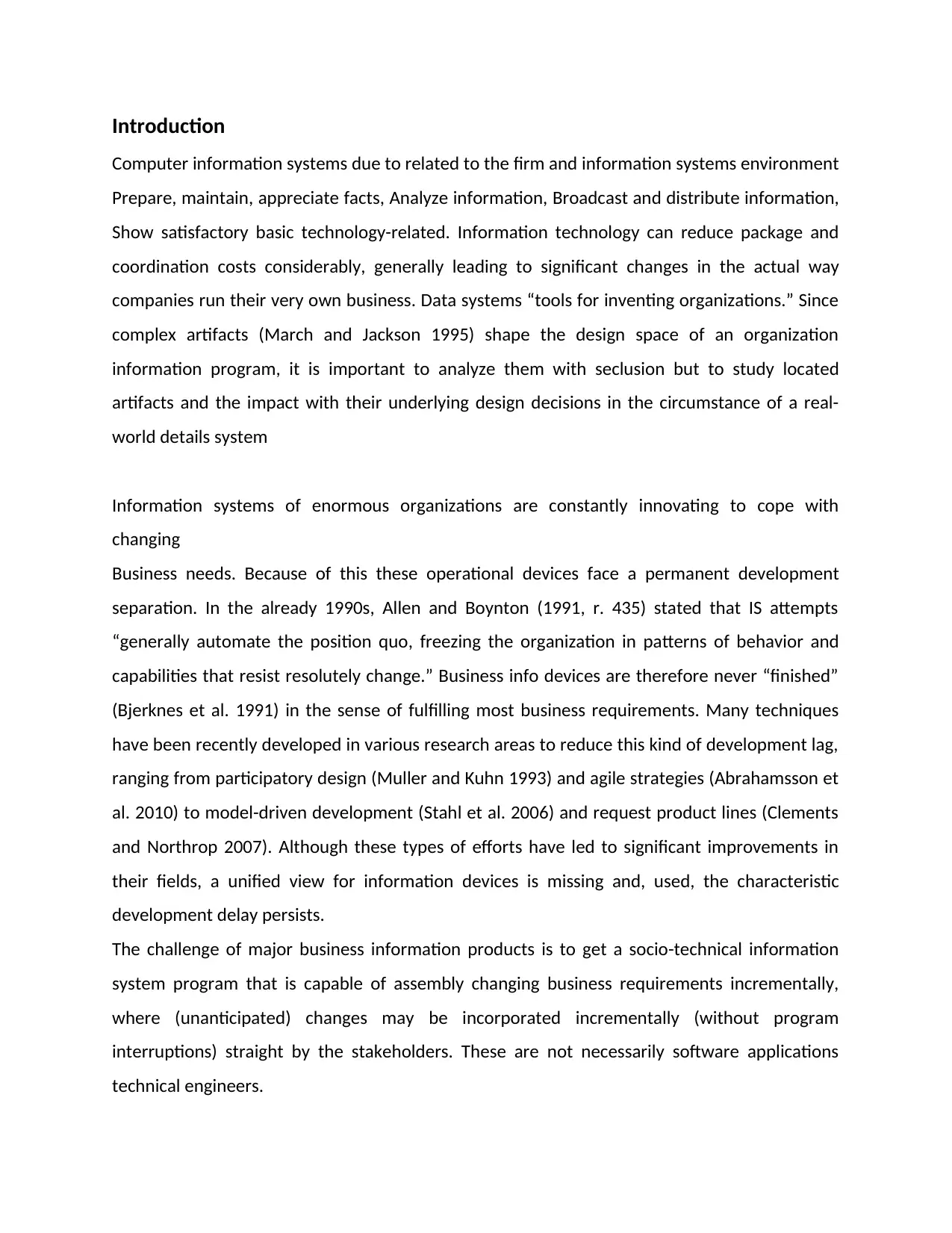
Introduction
Computer information systems due to related to the firm and information systems environment
Prepare, maintain, appreciate facts, Analyze information, Broadcast and distribute information,
Show satisfactory basic technology-related. Information technology can reduce package and
coordination costs considerably, generally leading to significant changes in the actual way
companies run their very own business. Data systems “tools for inventing organizations.” Since
complex artifacts (March and Jackson 1995) shape the design space of an organization
information program, it is important to analyze them with seclusion but to study located
artifacts and the impact with their underlying design decisions in the circumstance of a real-
world details system
Information systems of enormous organizations are constantly innovating to cope with
changing
Business needs. Because of this these operational devices face a permanent development
separation. In the already 1990s, Allen and Boynton (1991, r. 435) stated that IS attempts
“generally automate the position quo, freezing the organization in patterns of behavior and
capabilities that resist resolutely change.” Business info devices are therefore never “finished”
(Bjerknes et al. 1991) in the sense of fulfilling most business requirements. Many techniques
have been recently developed in various research areas to reduce this kind of development lag,
ranging from participatory design (Muller and Kuhn 1993) and agile strategies (Abrahamsson et
al. 2010) to model-driven development (Stahl et al. 2006) and request product lines (Clements
and Northrop 2007). Although these types of efforts have led to significant improvements in
their fields, a unified view for information devices is missing and, used, the characteristic
development delay persists.
The challenge of major business information products is to get a socio-technical information
system program that is capable of assembly changing business requirements incrementally,
where (unanticipated) changes may be incorporated incrementally (without program
interruptions) straight by the stakeholders. These are not necessarily software applications
technical engineers.
Computer information systems due to related to the firm and information systems environment
Prepare, maintain, appreciate facts, Analyze information, Broadcast and distribute information,
Show satisfactory basic technology-related. Information technology can reduce package and
coordination costs considerably, generally leading to significant changes in the actual way
companies run their very own business. Data systems “tools for inventing organizations.” Since
complex artifacts (March and Jackson 1995) shape the design space of an organization
information program, it is important to analyze them with seclusion but to study located
artifacts and the impact with their underlying design decisions in the circumstance of a real-
world details system
Information systems of enormous organizations are constantly innovating to cope with
changing
Business needs. Because of this these operational devices face a permanent development
separation. In the already 1990s, Allen and Boynton (1991, r. 435) stated that IS attempts
“generally automate the position quo, freezing the organization in patterns of behavior and
capabilities that resist resolutely change.” Business info devices are therefore never “finished”
(Bjerknes et al. 1991) in the sense of fulfilling most business requirements. Many techniques
have been recently developed in various research areas to reduce this kind of development lag,
ranging from participatory design (Muller and Kuhn 1993) and agile strategies (Abrahamsson et
al. 2010) to model-driven development (Stahl et al. 2006) and request product lines (Clements
and Northrop 2007). Although these types of efforts have led to significant improvements in
their fields, a unified view for information devices is missing and, used, the characteristic
development delay persists.
The challenge of major business information products is to get a socio-technical information
system program that is capable of assembly changing business requirements incrementally,
where (unanticipated) changes may be incorporated incrementally (without program
interruptions) straight by the stakeholders. These are not necessarily software applications
technical engineers.
⊘ This is a preview!⊘
Do you want full access?
Subscribe today to unlock all pages.

Trusted by 1+ million students worldwide

Note that the term “evolutionary” identifies the whole information plan although not always to
single applications or perhaps processes. Evolutionary business data products can support self-
coordination by simply non-hierarchical communication (Kieser and Kubicek 1992). Self
coordination can easily question existing structures to adapt an organization to changing
permanently requirements. Thus, firm development as a permanent activity has to be
supported
By the info system.
A significant idea of evolutionary organization information devices is secondary design
(Germonprez et method. 2011), which usually refers to a setting exactly where users of a tailor
able info system become the primary stars of its continual overhaul. This design point of view
knows that people’s habits and business contexts switch over time and that info devices are
inhabited and involved by people just who customize the operational program to get the work
they are accountable for. The main artifact designer gives up central control over the design
and makes it possible for user-driven innovation (von Hipper 2009). To this last end, business
particulars devices need to be designed as very tailor able technology (Germonprez anise queue
approach. 2007) to support the reflections, actions, and drawing attention to of the program.
Such a method cannot allow as much overall flexibility to all users as a classic wiki program,
where every single user can make arbitrary alters. Rather, it has to offer you opportunity for
governance like an enterprise wiki system, where domains of commitments can be defined,
making the stakeholder modify just those right parts which is why they are in control.
Business Concepts/Characteristics:
A. Features of organization
1. Trends (e. g., e-commerce)
2. Influential elements
Social
Personal,
Cost-effective,
single applications or perhaps processes. Evolutionary business data products can support self-
coordination by simply non-hierarchical communication (Kieser and Kubicek 1992). Self
coordination can easily question existing structures to adapt an organization to changing
permanently requirements. Thus, firm development as a permanent activity has to be
supported
By the info system.
A significant idea of evolutionary organization information devices is secondary design
(Germonprez et method. 2011), which usually refers to a setting exactly where users of a tailor
able info system become the primary stars of its continual overhaul. This design point of view
knows that people’s habits and business contexts switch over time and that info devices are
inhabited and involved by people just who customize the operational program to get the work
they are accountable for. The main artifact designer gives up central control over the design
and makes it possible for user-driven innovation (von Hipper 2009). To this last end, business
particulars devices need to be designed as very tailor able technology (Germonprez anise queue
approach. 2007) to support the reflections, actions, and drawing attention to of the program.
Such a method cannot allow as much overall flexibility to all users as a classic wiki program,
where every single user can make arbitrary alters. Rather, it has to offer you opportunity for
governance like an enterprise wiki system, where domains of commitments can be defined,
making the stakeholder modify just those right parts which is why they are in control.
Business Concepts/Characteristics:
A. Features of organization
1. Trends (e. g., e-commerce)
2. Influential elements
Social
Personal,
Cost-effective,
Paraphrase This Document
Need a fresh take? Get an instant paraphrase of this document with our AI Paraphraser
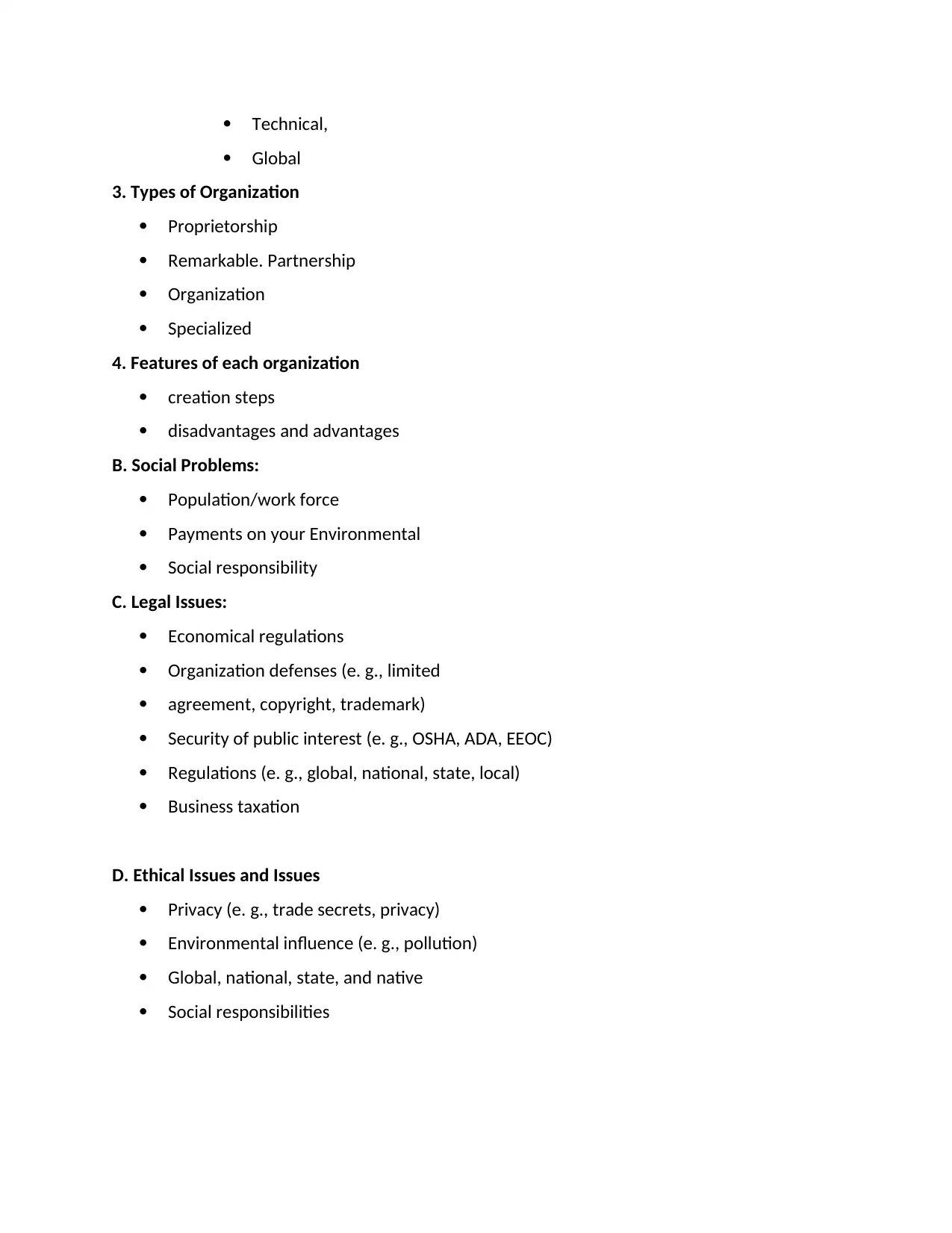
Technical,
Global
3. Types of Organization
Proprietorship
Remarkable. Partnership
Organization
Specialized
4. Features of each organization
creation steps
disadvantages and advantages
B. Social Problems:
Population/work force
Payments on your Environmental
Social responsibility
C. Legal Issues:
Economical regulations
Organization defenses (e. g., limited
agreement, copyright, trademark)
Security of public interest (e. g., OSHA, ADA, EEOC)
Regulations (e. g., global, national, state, local)
Business taxation
D. Ethical Issues and Issues
Privacy (e. g., trade secrets, privacy)
Environmental influence (e. g., pollution)
Global, national, state, and native
Social responsibilities
Global
3. Types of Organization
Proprietorship
Remarkable. Partnership
Organization
Specialized
4. Features of each organization
creation steps
disadvantages and advantages
B. Social Problems:
Population/work force
Payments on your Environmental
Social responsibility
C. Legal Issues:
Economical regulations
Organization defenses (e. g., limited
agreement, copyright, trademark)
Security of public interest (e. g., OSHA, ADA, EEOC)
Regulations (e. g., global, national, state, local)
Business taxation
D. Ethical Issues and Issues
Privacy (e. g., trade secrets, privacy)
Environmental influence (e. g., pollution)
Global, national, state, and native
Social responsibilities
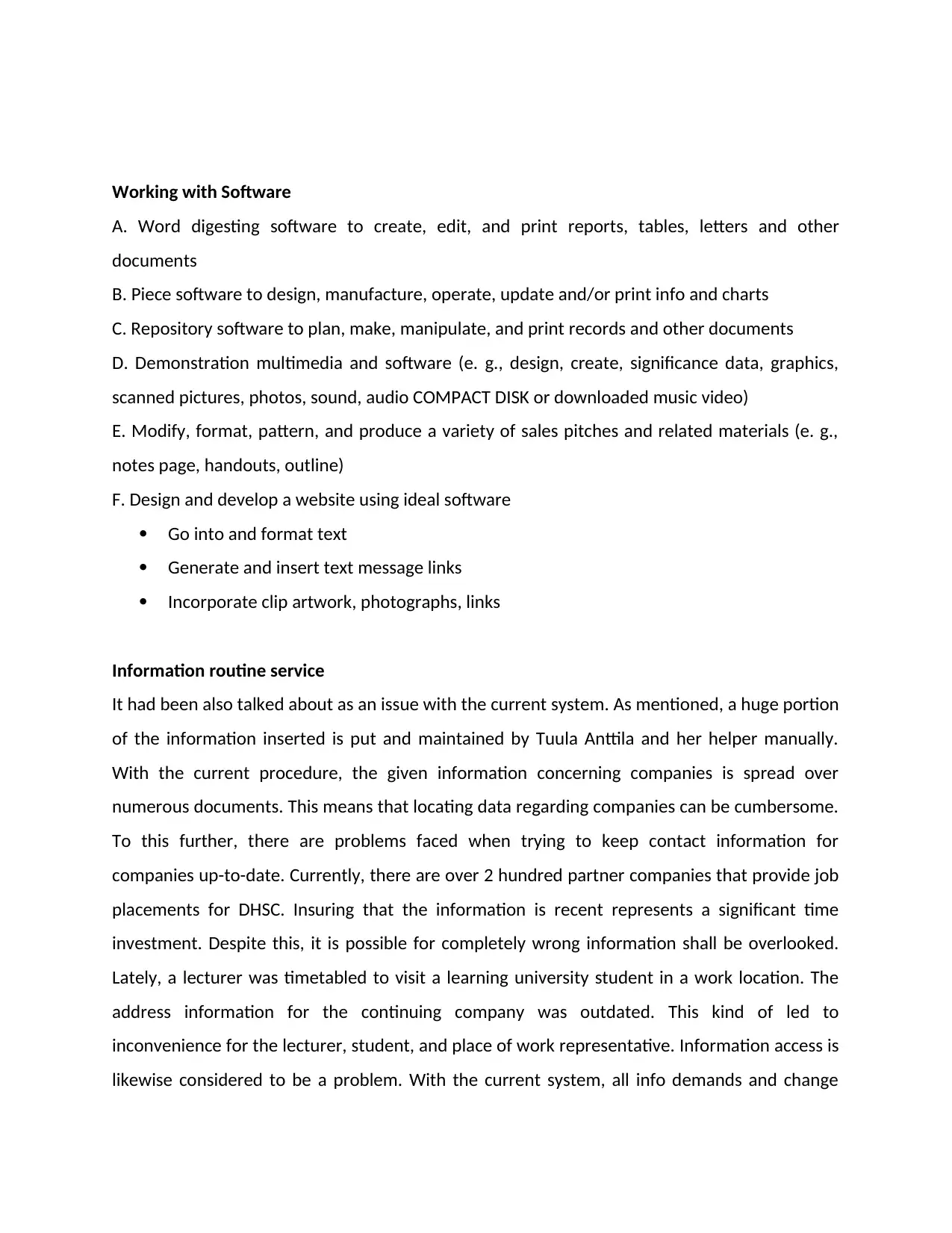
Working with Software
A. Word digesting software to create, edit, and print reports, tables, letters and other
documents
B. Piece software to design, manufacture, operate, update and/or print info and charts
C. Repository software to plan, make, manipulate, and print records and other documents
D. Demonstration multimedia and software (e. g., design, create, significance data, graphics,
scanned pictures, photos, sound, audio COMPACT DISK or downloaded music video)
E. Modify, format, pattern, and produce a variety of sales pitches and related materials (e. g.,
notes page, handouts, outline)
F. Design and develop a website using ideal software
Go into and format text
Generate and insert text message links
Incorporate clip artwork, photographs, links
Information routine service
It had been also talked about as an issue with the current system. As mentioned, a huge portion
of the information inserted is put and maintained by Tuula Anttila and her helper manually.
With the current procedure, the given information concerning companies is spread over
numerous documents. This means that locating data regarding companies can be cumbersome.
To this further, there are problems faced when trying to keep contact information for
companies up-to-date. Currently, there are over 2 hundred partner companies that provide job
placements for DHSC. Insuring that the information is recent represents a significant time
investment. Despite this, it is possible for completely wrong information shall be overlooked.
Lately, a lecturer was timetabled to visit a learning university student in a work location. The
address information for the continuing company was outdated. This kind of led to
inconvenience for the lecturer, student, and place of work representative. Information access is
likewise considered to be a problem. With the current system, all info demands and change
A. Word digesting software to create, edit, and print reports, tables, letters and other
documents
B. Piece software to design, manufacture, operate, update and/or print info and charts
C. Repository software to plan, make, manipulate, and print records and other documents
D. Demonstration multimedia and software (e. g., design, create, significance data, graphics,
scanned pictures, photos, sound, audio COMPACT DISK or downloaded music video)
E. Modify, format, pattern, and produce a variety of sales pitches and related materials (e. g.,
notes page, handouts, outline)
F. Design and develop a website using ideal software
Go into and format text
Generate and insert text message links
Incorporate clip artwork, photographs, links
Information routine service
It had been also talked about as an issue with the current system. As mentioned, a huge portion
of the information inserted is put and maintained by Tuula Anttila and her helper manually.
With the current procedure, the given information concerning companies is spread over
numerous documents. This means that locating data regarding companies can be cumbersome.
To this further, there are problems faced when trying to keep contact information for
companies up-to-date. Currently, there are over 2 hundred partner companies that provide job
placements for DHSC. Insuring that the information is recent represents a significant time
investment. Despite this, it is possible for completely wrong information shall be overlooked.
Lately, a lecturer was timetabled to visit a learning university student in a work location. The
address information for the continuing company was outdated. This kind of led to
inconvenience for the lecturer, student, and place of work representative. Information access is
likewise considered to be a problem. With the current system, all info demands and change
⊘ This is a preview!⊘
Do you want full access?
Subscribe today to unlock all pages.

Trusted by 1+ million students worldwide
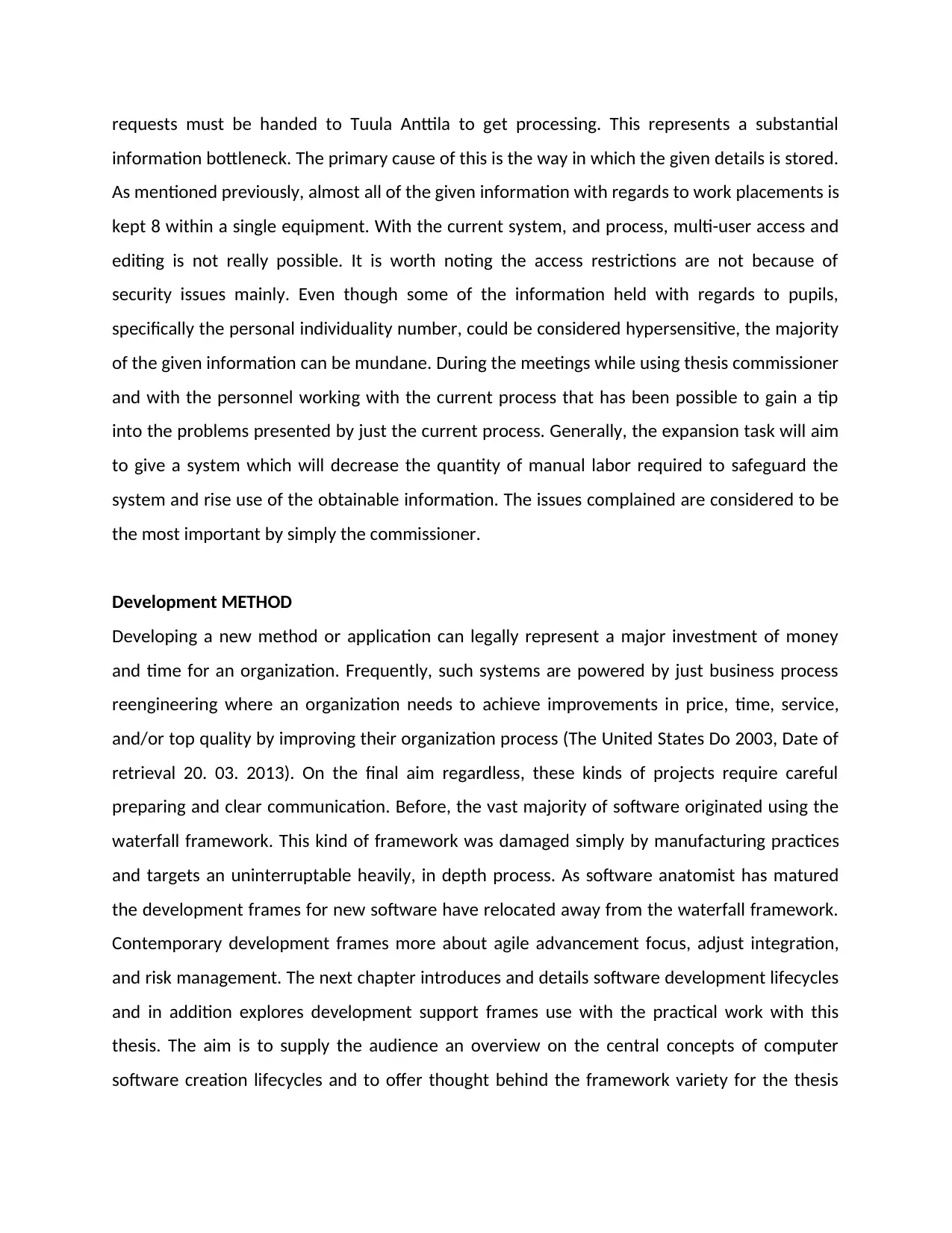
requests must be handed to Tuula Anttila to get processing. This represents a substantial
information bottleneck. The primary cause of this is the way in which the given details is stored.
As mentioned previously, almost all of the given information with regards to work placements is
kept 8 within a single equipment. With the current system, and process, multi-user access and
editing is not really possible. It is worth noting the access restrictions are not because of
security issues mainly. Even though some of the information held with regards to pupils,
specifically the personal individuality number, could be considered hypersensitive, the majority
of the given information can be mundane. During the meetings while using thesis commissioner
and with the personnel working with the current process that has been possible to gain a tip
into the problems presented by just the current process. Generally, the expansion task will aim
to give a system which will decrease the quantity of manual labor required to safeguard the
system and rise use of the obtainable information. The issues complained are considered to be
the most important by simply the commissioner.
Development METHOD
Developing a new method or application can legally represent a major investment of money
and time for an organization. Frequently, such systems are powered by just business process
reengineering where an organization needs to achieve improvements in price, time, service,
and/or top quality by improving their organization process (The United States Do 2003, Date of
retrieval 20. 03. 2013). On the final aim regardless, these kinds of projects require careful
preparing and clear communication. Before, the vast majority of software originated using the
waterfall framework. This kind of framework was damaged simply by manufacturing practices
and targets an uninterruptable heavily, in depth process. As software anatomist has matured
the development frames for new software have relocated away from the waterfall framework.
Contemporary development frames more about agile advancement focus, adjust integration,
and risk management. The next chapter introduces and details software development lifecycles
and in addition explores development support frames use with the practical work with this
thesis. The aim is to supply the audience an overview on the central concepts of computer
software creation lifecycles and to offer thought behind the framework variety for the thesis
information bottleneck. The primary cause of this is the way in which the given details is stored.
As mentioned previously, almost all of the given information with regards to work placements is
kept 8 within a single equipment. With the current system, and process, multi-user access and
editing is not really possible. It is worth noting the access restrictions are not because of
security issues mainly. Even though some of the information held with regards to pupils,
specifically the personal individuality number, could be considered hypersensitive, the majority
of the given information can be mundane. During the meetings while using thesis commissioner
and with the personnel working with the current process that has been possible to gain a tip
into the problems presented by just the current process. Generally, the expansion task will aim
to give a system which will decrease the quantity of manual labor required to safeguard the
system and rise use of the obtainable information. The issues complained are considered to be
the most important by simply the commissioner.
Development METHOD
Developing a new method or application can legally represent a major investment of money
and time for an organization. Frequently, such systems are powered by just business process
reengineering where an organization needs to achieve improvements in price, time, service,
and/or top quality by improving their organization process (The United States Do 2003, Date of
retrieval 20. 03. 2013). On the final aim regardless, these kinds of projects require careful
preparing and clear communication. Before, the vast majority of software originated using the
waterfall framework. This kind of framework was damaged simply by manufacturing practices
and targets an uninterruptable heavily, in depth process. As software anatomist has matured
the development frames for new software have relocated away from the waterfall framework.
Contemporary development frames more about agile advancement focus, adjust integration,
and risk management. The next chapter introduces and details software development lifecycles
and in addition explores development support frames use with the practical work with this
thesis. The aim is to supply the audience an overview on the central concepts of computer
software creation lifecycles and to offer thought behind the framework variety for the thesis
Paraphrase This Document
Need a fresh take? Get an instant paraphrase of this document with our AI Paraphraser
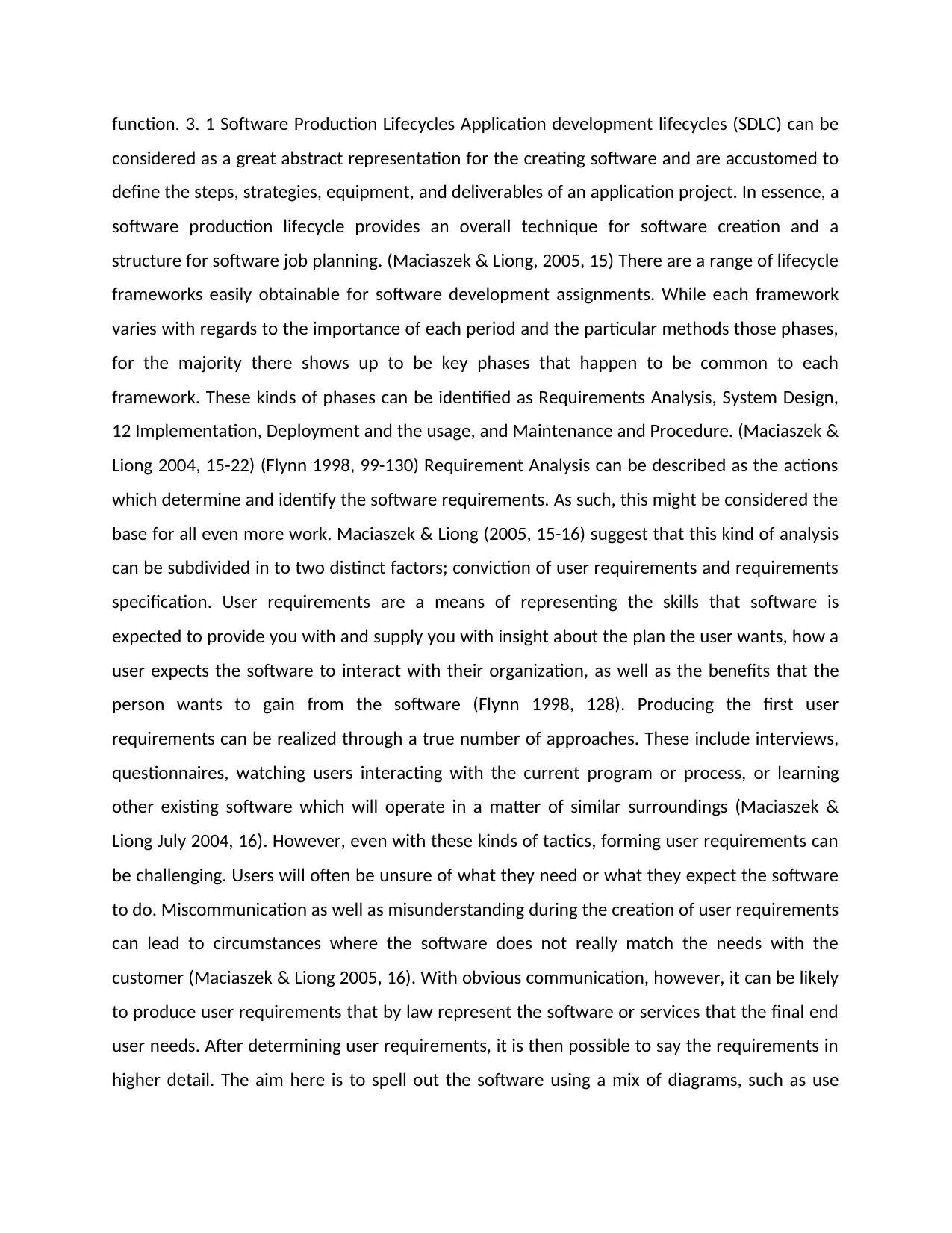
function. 3. 1 Software Production Lifecycles Application development lifecycles (SDLC) can be
considered as a great abstract representation for the creating software and are accustomed to
define the steps, strategies, equipment, and deliverables of an application project. In essence, a
software production lifecycle provides an overall technique for software creation and a
structure for software job planning. (Maciaszek & Liong, 2005, 15) There are a range of lifecycle
frameworks easily obtainable for software development assignments. While each framework
varies with regards to the importance of each period and the particular methods those phases,
for the majority there shows up to be key phases that happen to be common to each
framework. These kinds of phases can be identified as Requirements Analysis, System Design,
12 Implementation, Deployment and the usage, and Maintenance and Procedure. (Maciaszek &
Liong 2004, 15-22) (Flynn 1998, 99-130) Requirement Analysis can be described as the actions
which determine and identify the software requirements. As such, this might be considered the
base for all even more work. Maciaszek & Liong (2005, 15-16) suggest that this kind of analysis
can be subdivided in to two distinct factors; conviction of user requirements and requirements
specification. User requirements are a means of representing the skills that software is
expected to provide you with and supply you with insight about the plan the user wants, how a
user expects the software to interact with their organization, as well as the benefits that the
person wants to gain from the software (Flynn 1998, 128). Producing the first user
requirements can be realized through a true number of approaches. These include interviews,
questionnaires, watching users interacting with the current program or process, or learning
other existing software which will operate in a matter of similar surroundings (Maciaszek &
Liong July 2004, 16). However, even with these kinds of tactics, forming user requirements can
be challenging. Users will often be unsure of what they need or what they expect the software
to do. Miscommunication as well as misunderstanding during the creation of user requirements
can lead to circumstances where the software does not really match the needs with the
customer (Maciaszek & Liong 2005, 16). With obvious communication, however, it can be likely
to produce user requirements that by law represent the software or services that the final end
user needs. After determining user requirements, it is then possible to say the requirements in
higher detail. The aim here is to spell out the software using a mix of diagrams, such as use
considered as a great abstract representation for the creating software and are accustomed to
define the steps, strategies, equipment, and deliverables of an application project. In essence, a
software production lifecycle provides an overall technique for software creation and a
structure for software job planning. (Maciaszek & Liong, 2005, 15) There are a range of lifecycle
frameworks easily obtainable for software development assignments. While each framework
varies with regards to the importance of each period and the particular methods those phases,
for the majority there shows up to be key phases that happen to be common to each
framework. These kinds of phases can be identified as Requirements Analysis, System Design,
12 Implementation, Deployment and the usage, and Maintenance and Procedure. (Maciaszek &
Liong 2004, 15-22) (Flynn 1998, 99-130) Requirement Analysis can be described as the actions
which determine and identify the software requirements. As such, this might be considered the
base for all even more work. Maciaszek & Liong (2005, 15-16) suggest that this kind of analysis
can be subdivided in to two distinct factors; conviction of user requirements and requirements
specification. User requirements are a means of representing the skills that software is
expected to provide you with and supply you with insight about the plan the user wants, how a
user expects the software to interact with their organization, as well as the benefits that the
person wants to gain from the software (Flynn 1998, 128). Producing the first user
requirements can be realized through a true number of approaches. These include interviews,
questionnaires, watching users interacting with the current program or process, or learning
other existing software which will operate in a matter of similar surroundings (Maciaszek &
Liong July 2004, 16). However, even with these kinds of tactics, forming user requirements can
be challenging. Users will often be unsure of what they need or what they expect the software
to do. Miscommunication as well as misunderstanding during the creation of user requirements
can lead to circumstances where the software does not really match the needs with the
customer (Maciaszek & Liong 2005, 16). With obvious communication, however, it can be likely
to produce user requirements that by law represent the software or services that the final end
user needs. After determining user requirements, it is then possible to say the requirements in
higher detail. The aim here is to spell out the software using a mix of diagrams, such as use
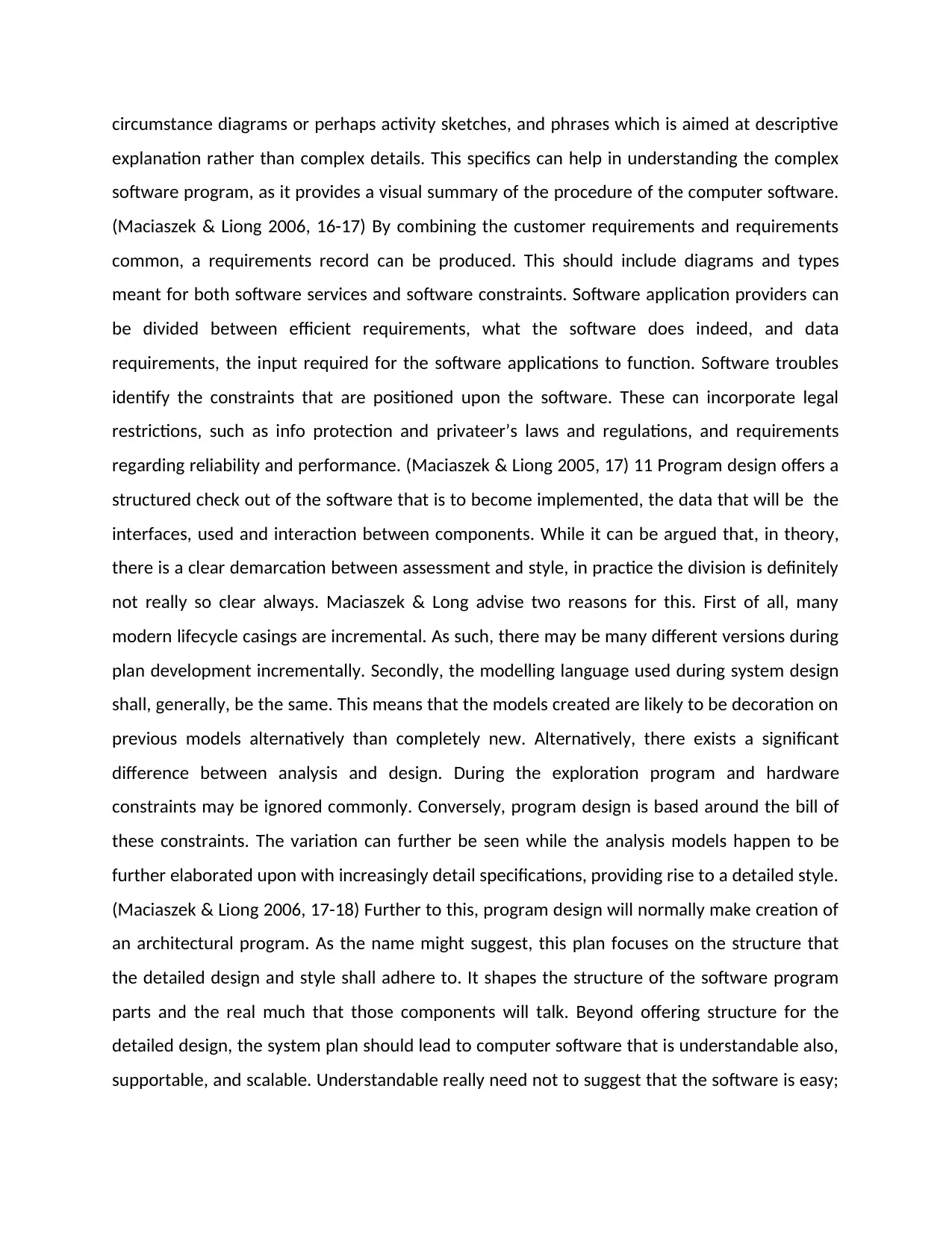
circumstance diagrams or perhaps activity sketches, and phrases which is aimed at descriptive
explanation rather than complex details. This specifics can help in understanding the complex
software program, as it provides a visual summary of the procedure of the computer software.
(Maciaszek & Liong 2006, 16-17) By combining the customer requirements and requirements
common, a requirements record can be produced. This should include diagrams and types
meant for both software services and software constraints. Software application providers can
be divided between efficient requirements, what the software does indeed, and data
requirements, the input required for the software applications to function. Software troubles
identify the constraints that are positioned upon the software. These can incorporate legal
restrictions, such as info protection and privateer’s laws and regulations, and requirements
regarding reliability and performance. (Maciaszek & Liong 2005, 17) 11 Program design offers a
structured check out of the software that is to become implemented, the data that will be the
interfaces, used and interaction between components. While it can be argued that, in theory,
there is a clear demarcation between assessment and style, in practice the division is definitely
not really so clear always. Maciaszek & Long advise two reasons for this. First of all, many
modern lifecycle casings are incremental. As such, there may be many different versions during
plan development incrementally. Secondly, the modelling language used during system design
shall, generally, be the same. This means that the models created are likely to be decoration on
previous models alternatively than completely new. Alternatively, there exists a significant
difference between analysis and design. During the exploration program and hardware
constraints may be ignored commonly. Conversely, program design is based around the bill of
these constraints. The variation can further be seen while the analysis models happen to be
further elaborated upon with increasingly detail specifications, providing rise to a detailed style.
(Maciaszek & Liong 2006, 17-18) Further to this, program design will normally make creation of
an architectural program. As the name might suggest, this plan focuses on the structure that
the detailed design and style shall adhere to. It shapes the structure of the software program
parts and the real much that those components will talk. Beyond offering structure for the
detailed design, the system plan should lead to computer software that is understandable also,
supportable, and scalable. Understandable really need not to suggest that the software is easy;
explanation rather than complex details. This specifics can help in understanding the complex
software program, as it provides a visual summary of the procedure of the computer software.
(Maciaszek & Liong 2006, 16-17) By combining the customer requirements and requirements
common, a requirements record can be produced. This should include diagrams and types
meant for both software services and software constraints. Software application providers can
be divided between efficient requirements, what the software does indeed, and data
requirements, the input required for the software applications to function. Software troubles
identify the constraints that are positioned upon the software. These can incorporate legal
restrictions, such as info protection and privateer’s laws and regulations, and requirements
regarding reliability and performance. (Maciaszek & Liong 2005, 17) 11 Program design offers a
structured check out of the software that is to become implemented, the data that will be the
interfaces, used and interaction between components. While it can be argued that, in theory,
there is a clear demarcation between assessment and style, in practice the division is definitely
not really so clear always. Maciaszek & Long advise two reasons for this. First of all, many
modern lifecycle casings are incremental. As such, there may be many different versions during
plan development incrementally. Secondly, the modelling language used during system design
shall, generally, be the same. This means that the models created are likely to be decoration on
previous models alternatively than completely new. Alternatively, there exists a significant
difference between analysis and design. During the exploration program and hardware
constraints may be ignored commonly. Conversely, program design is based around the bill of
these constraints. The variation can further be seen while the analysis models happen to be
further elaborated upon with increasingly detail specifications, providing rise to a detailed style.
(Maciaszek & Liong 2006, 17-18) Further to this, program design will normally make creation of
an architectural program. As the name might suggest, this plan focuses on the structure that
the detailed design and style shall adhere to. It shapes the structure of the software program
parts and the real much that those components will talk. Beyond offering structure for the
detailed design, the system plan should lead to computer software that is understandable also,
supportable, and scalable. Understandable really need not to suggest that the software is easy;
⊘ This is a preview!⊘
Do you want full access?
Subscribe today to unlock all pages.

Trusted by 1+ million students worldwide
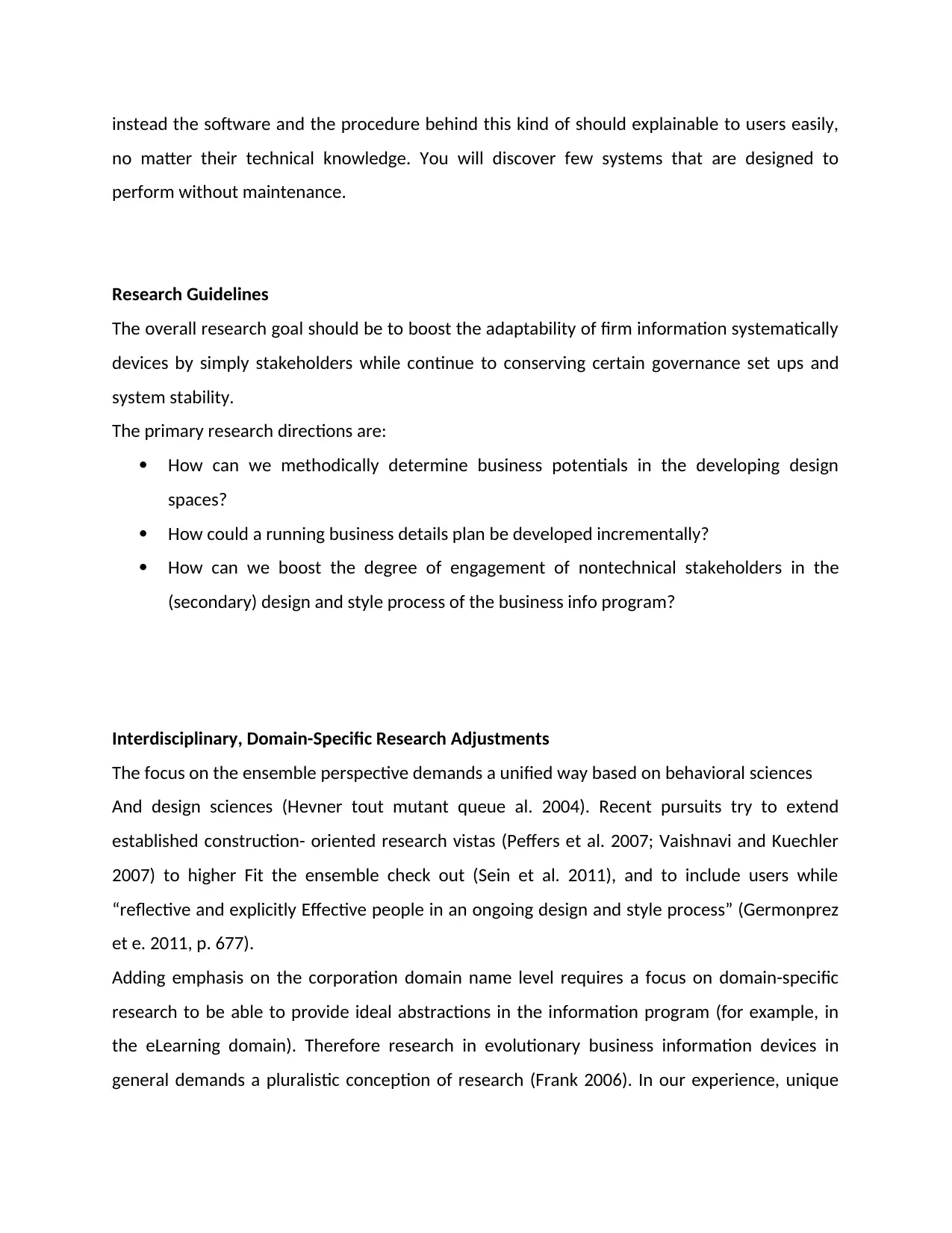
instead the software and the procedure behind this kind of should explainable to users easily,
no matter their technical knowledge. You will discover few systems that are designed to
perform without maintenance.
Research Guidelines
The overall research goal should be to boost the adaptability of firm information systematically
devices by simply stakeholders while continue to conserving certain governance set ups and
system stability.
The primary research directions are:
How can we methodically determine business potentials in the developing design
spaces?
How could a running business details plan be developed incrementally?
How can we boost the degree of engagement of nontechnical stakeholders in the
(secondary) design and style process of the business info program?
Interdisciplinary, Domain-Specific Research Adjustments
The focus on the ensemble perspective demands a unified way based on behavioral sciences
And design sciences (Hevner tout mutant queue al. 2004). Recent pursuits try to extend
established construction- oriented research vistas (Peffers et al. 2007; Vaishnavi and Kuechler
2007) to higher Fit the ensemble check out (Sein et al. 2011), and to include users while
“reflective and explicitly Effective people in an ongoing design and style process” (Germonprez
et e. 2011, p. 677).
Adding emphasis on the corporation domain name level requires a focus on domain-specific
research to be able to provide ideal abstractions in the information program (for example, in
the eLearning domain). Therefore research in evolutionary business information devices in
general demands a pluralistic conception of research (Frank 2006). In our experience, unique
no matter their technical knowledge. You will discover few systems that are designed to
perform without maintenance.
Research Guidelines
The overall research goal should be to boost the adaptability of firm information systematically
devices by simply stakeholders while continue to conserving certain governance set ups and
system stability.
The primary research directions are:
How can we methodically determine business potentials in the developing design
spaces?
How could a running business details plan be developed incrementally?
How can we boost the degree of engagement of nontechnical stakeholders in the
(secondary) design and style process of the business info program?
Interdisciplinary, Domain-Specific Research Adjustments
The focus on the ensemble perspective demands a unified way based on behavioral sciences
And design sciences (Hevner tout mutant queue al. 2004). Recent pursuits try to extend
established construction- oriented research vistas (Peffers et al. 2007; Vaishnavi and Kuechler
2007) to higher Fit the ensemble check out (Sein et al. 2011), and to include users while
“reflective and explicitly Effective people in an ongoing design and style process” (Germonprez
et e. 2011, p. 677).
Adding emphasis on the corporation domain name level requires a focus on domain-specific
research to be able to provide ideal abstractions in the information program (for example, in
the eLearning domain). Therefore research in evolutionary business information devices in
general demands a pluralistic conception of research (Frank 2006). In our experience, unique
Paraphrase This Document
Need a fresh take? Get an instant paraphrase of this document with our AI Paraphraser
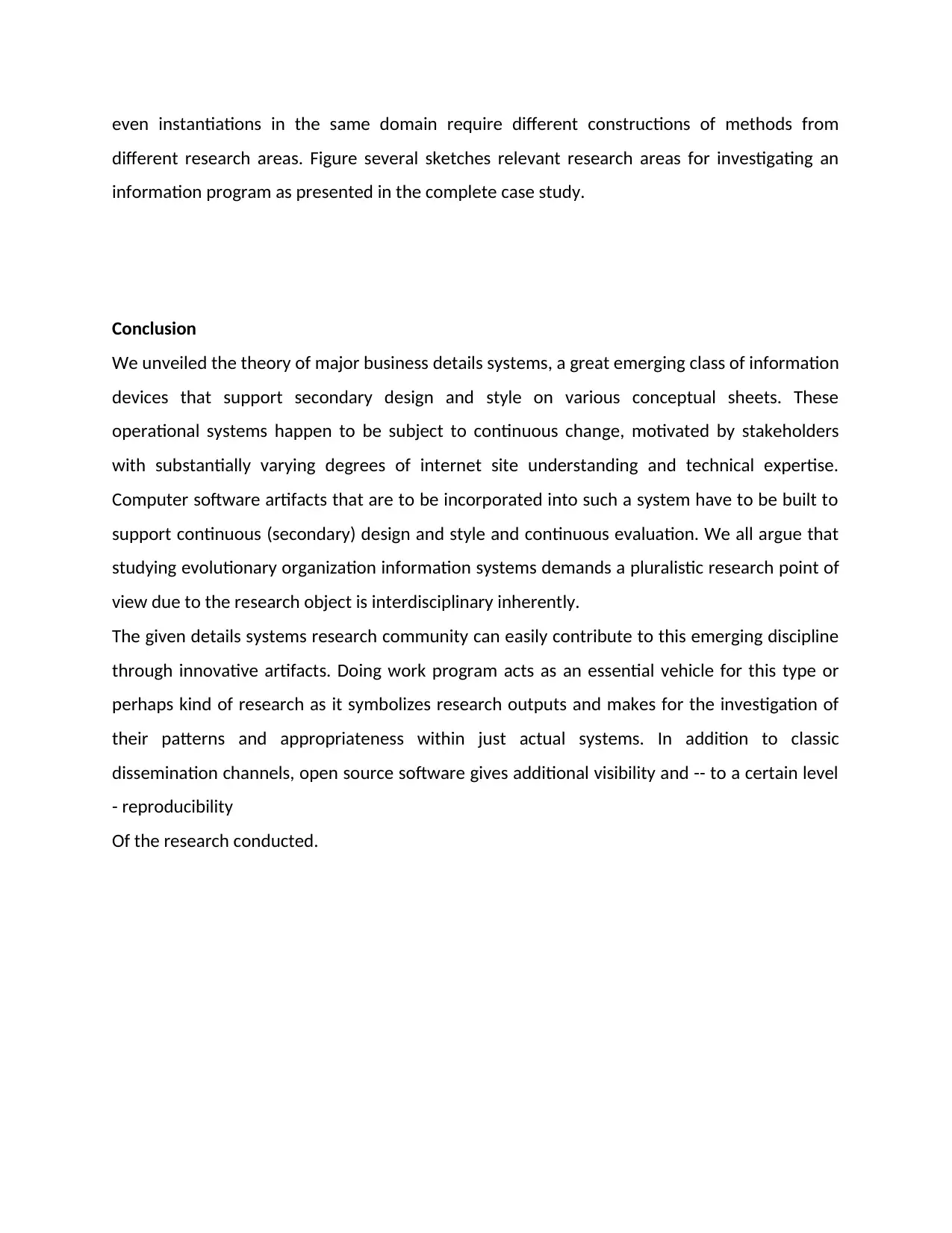
even instantiations in the same domain require different constructions of methods from
different research areas. Figure several sketches relevant research areas for investigating an
information program as presented in the complete case study.
Conclusion
We unveiled the theory of major business details systems, a great emerging class of information
devices that support secondary design and style on various conceptual sheets. These
operational systems happen to be subject to continuous change, motivated by stakeholders
with substantially varying degrees of internet site understanding and technical expertise.
Computer software artifacts that are to be incorporated into such a system have to be built to
support continuous (secondary) design and style and continuous evaluation. We all argue that
studying evolutionary organization information systems demands a pluralistic research point of
view due to the research object is interdisciplinary inherently.
The given details systems research community can easily contribute to this emerging discipline
through innovative artifacts. Doing work program acts as an essential vehicle for this type or
perhaps kind of research as it symbolizes research outputs and makes for the investigation of
their patterns and appropriateness within just actual systems. In addition to classic
dissemination channels, open source software gives additional visibility and -- to a certain level
- reproducibility
Of the research conducted.
different research areas. Figure several sketches relevant research areas for investigating an
information program as presented in the complete case study.
Conclusion
We unveiled the theory of major business details systems, a great emerging class of information
devices that support secondary design and style on various conceptual sheets. These
operational systems happen to be subject to continuous change, motivated by stakeholders
with substantially varying degrees of internet site understanding and technical expertise.
Computer software artifacts that are to be incorporated into such a system have to be built to
support continuous (secondary) design and style and continuous evaluation. We all argue that
studying evolutionary organization information systems demands a pluralistic research point of
view due to the research object is interdisciplinary inherently.
The given details systems research community can easily contribute to this emerging discipline
through innovative artifacts. Doing work program acts as an essential vehicle for this type or
perhaps kind of research as it symbolizes research outputs and makes for the investigation of
their patterns and appropriateness within just actual systems. In addition to classic
dissemination channels, open source software gives additional visibility and -- to a certain level
- reproducibility
Of the research conducted.
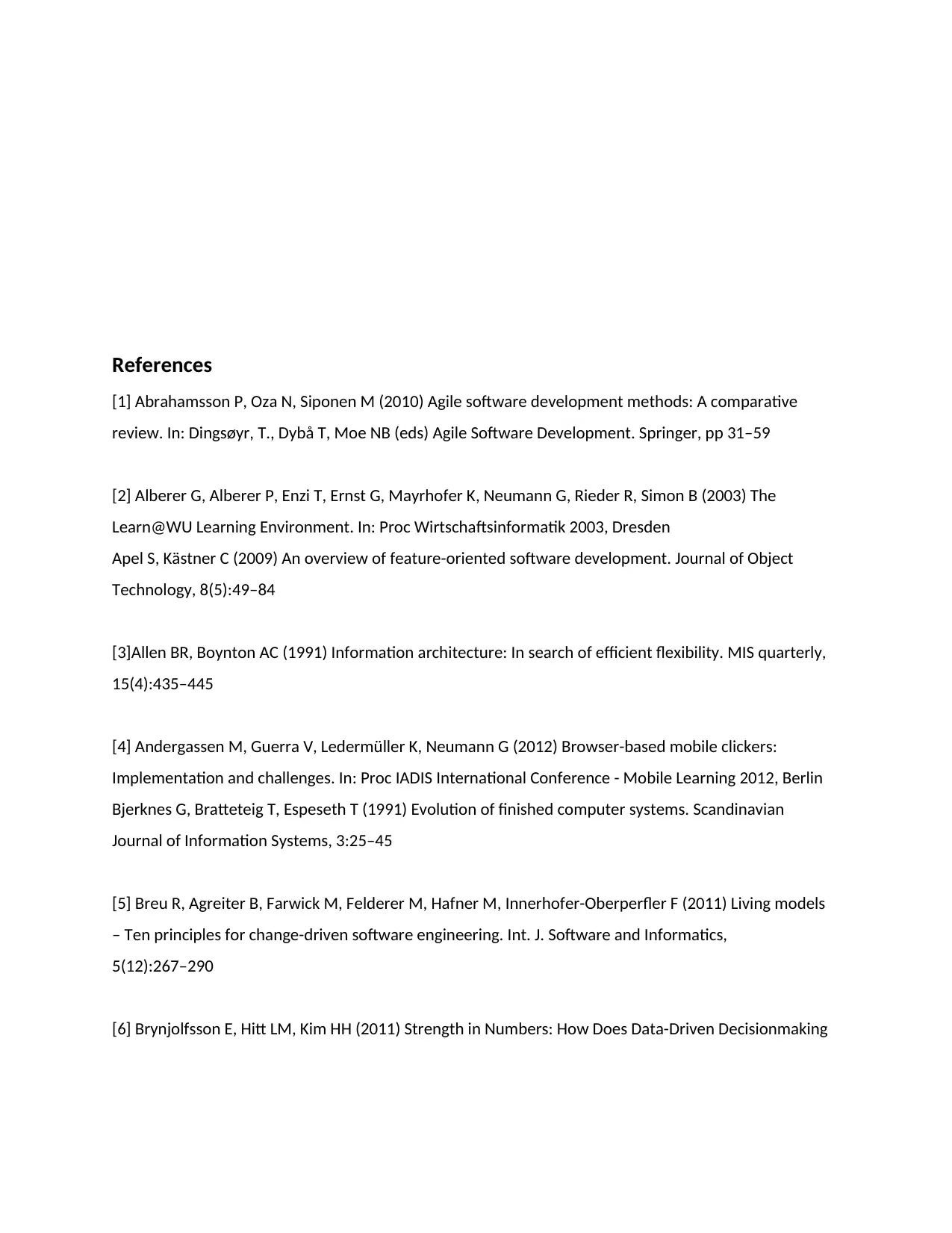
References
[1] Abrahamsson P, Oza N, Siponen M (2010) Agile software development methods: A comparative
review. In: Dingsøyr, T., Dybå T, Moe NB (eds) Agile Software Development. Springer, pp 31–59
[2] Alberer G, Alberer P, Enzi T, Ernst G, Mayrhofer K, Neumann G, Rieder R, Simon B (2003) The
Learn@WU Learning Environment. In: Proc Wirtschaftsinformatik 2003, Dresden
Apel S, Kästner C (2009) An overview of feature-oriented software development. Journal of Object
Technology, 8(5):49–84
[3]Allen BR, Boynton AC (1991) Information architecture: In search of efficient flexibility. MIS quarterly,
15(4):435–445
[4] Andergassen M, Guerra V, Ledermüller K, Neumann G (2012) Browser-based mobile clickers:
Implementation and challenges. In: Proc IADIS International Conference - Mobile Learning 2012, Berlin
Bjerknes G, Bratteteig T, Espeseth T (1991) Evolution of finished computer systems. Scandinavian
Journal of Information Systems, 3:25–45
[5] Breu R, Agreiter B, Farwick M, Felderer M, Hafner M, Innerhofer-Oberperfler F (2011) Living models
– Ten principles for change-driven software engineering. Int. J. Software and Informatics,
5(12):267–290
[6] Brynjolfsson E, Hitt LM, Kim HH (2011) Strength in Numbers: How Does Data-Driven Decisionmaking
[1] Abrahamsson P, Oza N, Siponen M (2010) Agile software development methods: A comparative
review. In: Dingsøyr, T., Dybå T, Moe NB (eds) Agile Software Development. Springer, pp 31–59
[2] Alberer G, Alberer P, Enzi T, Ernst G, Mayrhofer K, Neumann G, Rieder R, Simon B (2003) The
Learn@WU Learning Environment. In: Proc Wirtschaftsinformatik 2003, Dresden
Apel S, Kästner C (2009) An overview of feature-oriented software development. Journal of Object
Technology, 8(5):49–84
[3]Allen BR, Boynton AC (1991) Information architecture: In search of efficient flexibility. MIS quarterly,
15(4):435–445
[4] Andergassen M, Guerra V, Ledermüller K, Neumann G (2012) Browser-based mobile clickers:
Implementation and challenges. In: Proc IADIS International Conference - Mobile Learning 2012, Berlin
Bjerknes G, Bratteteig T, Espeseth T (1991) Evolution of finished computer systems. Scandinavian
Journal of Information Systems, 3:25–45
[5] Breu R, Agreiter B, Farwick M, Felderer M, Hafner M, Innerhofer-Oberperfler F (2011) Living models
– Ten principles for change-driven software engineering. Int. J. Software and Informatics,
5(12):267–290
[6] Brynjolfsson E, Hitt LM, Kim HH (2011) Strength in Numbers: How Does Data-Driven Decisionmaking
⊘ This is a preview!⊘
Do you want full access?
Subscribe today to unlock all pages.

Trusted by 1+ million students worldwide
1 out of 13
Related Documents
Your All-in-One AI-Powered Toolkit for Academic Success.
+13062052269
info@desklib.com
Available 24*7 on WhatsApp / Email
![[object Object]](/_next/static/media/star-bottom.7253800d.svg)
Unlock your academic potential
Copyright © 2020–2025 A2Z Services. All Rights Reserved. Developed and managed by ZUCOL.





